Philadelphia Convenes Private Sector on Climate Action

Philadelphia is a leader in addressing climate change. Mayor Jim Kenney has committed Philadelphia to cut citywide carbon emissions by at least 80 percent and achieve a carbon-free grid by 2050. Realizing the need for ambitious and coordinated efforts to achieve these goals, Mayor Kenney launched the Climate Collaborative of Greater Philadelphia earlier this month. The Climate Collaborative of Greater Philadelphia will connect businesses, colleges and universities, cultural institutions, and other large organizations to share best practices around setting and achieving climate goals.
Institutions in Philadelphia rose to the occasion with 39 businesses, universities, non-profits and community leaders signing onto the Collaborative at the time of launch and more commitments expected. As signatories, these institutions agreed to publicly adopt climate goals or recommit to those adopted previously.
Philadelphia’s Mayor and Office of Sustainability know that taking the action needed in the next decade to prevent the worst effects of climate change is difficult, but they have risen to challenge. The City has already conducted deep energy retrofits in its downtown office buildings and the Philadelphia Museum of Art, entered into a solar power purchase agreement (PPA) that will produce enough electricity to operate 22 percent of government operations, and adopted a building code to make new commercial buildings 30 percent more efficient. Philadelphia City Council is currently considering legislation to expand energy efficiency measures in the City’s largest existing commercial buildings, cutting carbon pollution an additional 5% citywide. Each of these initiatives have taught the City that, while this work is difficult, with the right support and technical expertise, it’s achievable.
With this in mind, and bolstered by the expertise gained through these initiatives, the City knew it could help the region’s institutions accelerate their climate action. The City followed the launch of the Collaborative by hosting a workshop to share best practices and expertise with large institutions. Facilitated by the Rocky Mountain Institute (RMI) and World Resources Institute (WRI), this day-long workshop focused on how to pursue renewable electricity PPAs. Regional businesses, universities, and institutions attended the workshop to learn about the complex way that energy is delivered to our homes and offices and begin to unpack how to procure renewable energy.
The day was chock full of deep, technical conversations and guidance around PPAs. There is no one-size-fits-all approach, so experts at RMI/WRI walked through the different options and variables that consumers may need to consider for their unique needs. There was a panel and Q&A with institutions who had gone through the process to talk candidly about what went well and areas of difficulty.
This type of support is only the beginning for this Collaborative, which has already received extensive interest and positive feedback from participants. Knowing that the demand is there, the City is positioned to continue providing resources and sharing best practices to reduce emissions with institutions. By developing this public-private partnership, the City is better positioned to meet its ambitious climate goals and take the action needed to create a healthy, vibrant future for the region.
The Climate Collaborative of Greater Philadelphia is one of many ways Philadelphia is working to respond to the climate crisis. Philadelphia is one of 25 cities in the American Cities Climate Challenge, a Bloomberg Philanthropies-funded project that provides technical and strategic support to reduce emissions in participating cities through buildings, energy use, and transportation.



